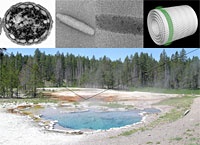May 14 2009
An international team of scientists, including researchers from two Dutch universities, Leiden and Groningen, has resolved the structure of chlorophyll in chlorosomes of green bacteria. Chlorosomes are the light-harvesting antennae of these bacteria. They are elongated small pockets which can accommodate up to 250,000 chlorophyll molecules.
 clockwise: bacteria with the chlorosomes on the inside of the membrane, chlorosomes, nanotubes, the geyser in Yellowstone Park where the bacteria live.
clockwise: bacteria with the chlorosomes on the inside of the membrane, chlorosomes, nanotubes, the geyser in Yellowstone Park where the bacteria live.
Nanotubes
The structure proves to be a combination of concentric nanotubes. This produces a robust yet plastic framework for the light-harvesting antennae. Within the nanotubes, the chlorophyl molecules form helices along which superfast energy migratin to proteins in the cell membrane occurs where the chemical conversion takes place.
Rings and tubes
To get from the microstructure to the nanotubes, yet another technique had to be used: cryo-electronmicroscopy, in Groningen. The Groningen researchers discovered very distinct patterns in the images, that can only be explained with a helical arrangement of the molecules. De Groot: ‘Once we realised that, it was possible to combine the dimensions from the EM with the precise measurements at molecular scale from the solid-state NMR to produce a very detailed structure of the chlorosome.' The result was a structure in which chlorophyll forms stacks and rings that self-assemble into concentric nanotubes. The corresponding structure of the wild type is less uniform, and has the stacks in another direction, approximately perpendicular to the stacking in the mutant. The structural framework thus provides insight into how similar chlorosome systems can be established in different ways. This insight is important for the construction of artificial sysems in a followng step.
New generations of solar energy collectors
De Groot: ‘The reason why chlorosomes are an attractive model for new generations of solar conversion devices is that they have a simple composition and work very well, even at very low light intensity. In natural photosynthesis the amount of sunlight is generally not the limiting factor. Green bacteria live, however, under extremely low light intensity, sometimes with only a few photons per chlorophyll molecule per day. To be able to survive on solar energy is a challenge and thanks to the PNAS research we now know much more about how nature has solved this problem. With the dense packing of chlorophyll molecules, there are strong links between the molecules and it is possible to combine thee nergy that is caught by more than the hundred thousand molecules joined together to generate sufficient flow for the conversion to chemical energy. Moreover, the structure protects itself against a surplus of light. The disorder in the stacking appears to help: a messier structure in this case happens to be better for biology. To apply the knowledge and new insights obtained from the biology in the translation to nanostructured materials fo the conversion of sunlight to fuel is now the next challenge.
Alternating syn-anti bacteriochlorophylls form concentric helical nanotubes in Chlorosomes.
Swapna Ganapathy, Gert T. Oostergetel, Piotr K. Wawryziniak, Michael Reus, Aline Gomez Maqueo Chew, Francesco Buda, Egbert J. Boekema, Donald A. Bryant, Alfred R. Holzwarth, Huub J.M. de Groot.
For the full press release, click here